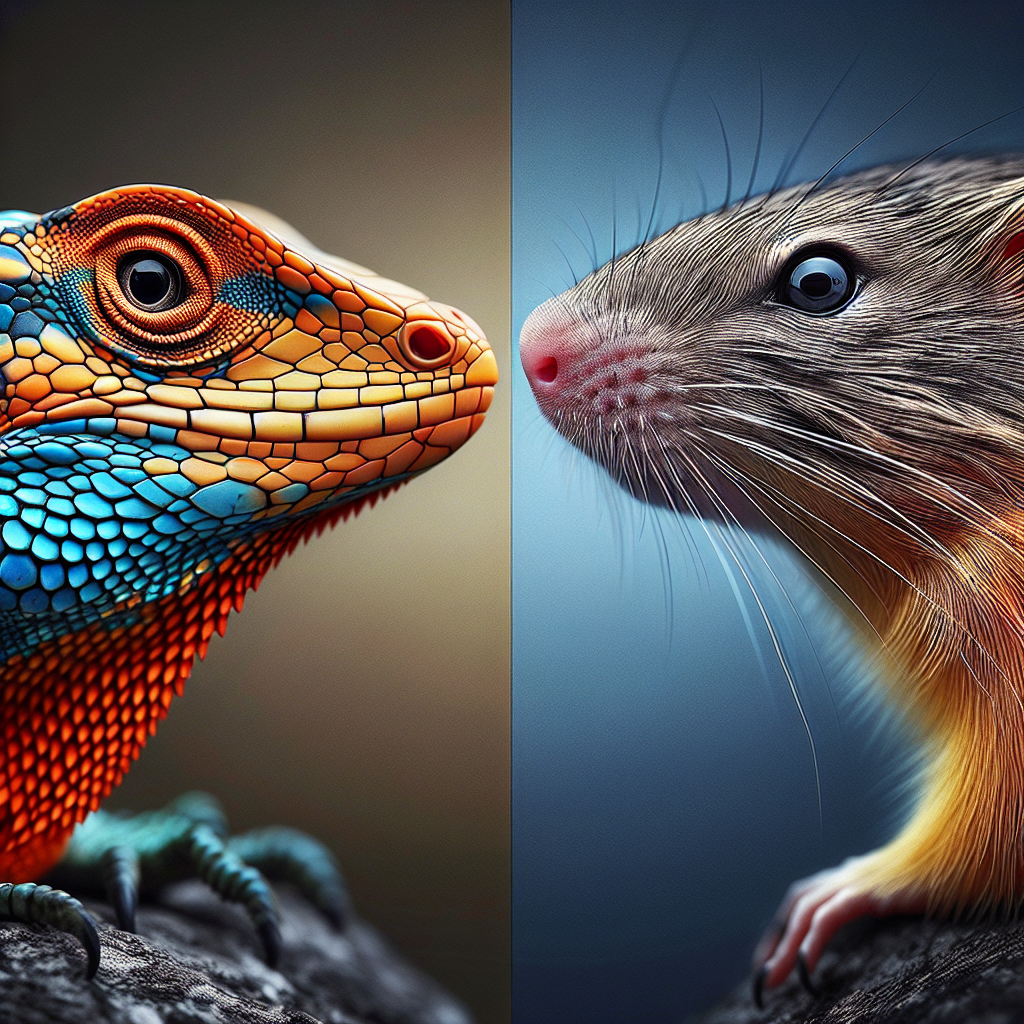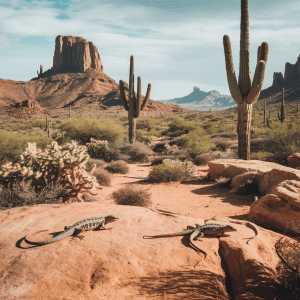Introduction: Lizards vs Mammals Comparison
Ever wondered what sets lizards apart from mammals? Well, let’s dive into the fascinating world of these creatures and explore their intriguing differences. When comparing lizards and mammals, it’s like comparing apples and oranges – they’re both fruit, but oh so different in their own ways.
Let’s start with the physical characteristics of lizards. Picture this: scales, claws, and that quick flick of the tongue to catch prey. Lizards are masters of camouflage, blending into their surroundings with ease. Now, imagine the soft fur, whiskers, and varied shapes and sizes of mammals. From the agile cheetah to the mighty elephant, the mammalian world is a diverse one.
Moving on to habitat variations, lizards thrive in diverse environments. Some prefer the arid deserts, while others call the lush rainforests home. On the other hand, mammals can be found in almost every corner of the globe, adapting to everything from icy tundras to scorching savannas.
Let’s not forget about diet. Lizards are known for their insectivorous habits, munching on crickets and worms with gusto. Meanwhile, mammals display a wide range of dietary preferences, from the herbivorous grazing of deer to the carnivorous hunting of lions.
Reproductive strategies offer another point of contrast. Lizards may lay eggs or give birth to live young, depending on the species. In contrast, mammals are known for their viviparous nature, nurturing their offspring within their bodies before giving birth.
Behavioral differences between lizards and mammals are equally intriguing. While lizards may bask in the sun to regulate their body temperature, mammals exhibit complex social behaviors like herding and pack hunting.
As we explore the adaptations to their environments, we uncover the incredible ways in which lizards and mammals have evolved to survive and thrive in their respective worlds. From the sticky toes of geckos to the insulating fur of polar bears, each adaptation tells a unique story of survival.
In conclusion, delving into the world of lizards and mammals reveals a tapestry of diversity and complexity. These creatures, though different in many ways, showcase the remarkable diversity of life on our planet.
Physical Characteristics of Lizards
Have you ever noticed the fascinating variety of physical characteristics that lizards possess? From their scaly skin to their diverse colors and patterns, these creatures are truly remarkable. One interesting fact about lizards is that they are ectothermic, meaning they rely on external heat sources to regulate their body temperature. This adaptation allows them to thrive in a wide range of environments, from deserts to rainforests.
When you observe a lizard up close, you can appreciate the intricate details of their scales and the agility of their movements. Some lizards have the ability to change color to blend in with their surroundings, a handy trick for avoiding predators. It’s like having a built-in invisibility cloak!
Additionally, the physical characteristics of lizards play a crucial role in their survival and behavior. For example, their long tails serve as a defense mechanism, allowing them to detach and escape from predators when necessary. And let’s not forget about their impressive climbing skills – watching a lizard effortlessly scale a vertical surface is both mesmerizing and impressive.
Understanding the physical characteristics of lizards not only provides insight into their biology but also highlights the incredible diversity of the animal kingdom. Next time you encounter a lizard, take a moment to appreciate the intricate details of their appearance and marvel at the wonders of nature.
Physical Characteristics of Mammals
Imagine you’re curious about the physical characteristics of lizards and mammals, and we’re chatting about it over a cup of coffee. Let’s dive into the fascinating world of these creatures!
When it comes to the physical characteristics of lizards, one interesting fact to note is their scaly skin. Just like a personal anecdote, I once visited a reptile sanctuary and was amazed by the intricate patterns and textures of a lizard’s skin up close. It’s like a unique piece of art!
On the other hand, mammals have a different set of physical characteristics. Did you know that mammals are typically covered in fur or hair? It’s a defining feature that sets them apart from other animal groups. Imagine a furry bear or a sleek dolphin – quite a contrast to the scaly exterior of a lizard!
Exploring the challenge or controversy surrounding the physical characteristics of these animals, some experts debate the evolutionary advantages of scales versus fur. Which adaptation do you think is more beneficial in terms of survival and environmental adaptation?
As we sip our coffee, let’s ponder this thought-provoking question: How do the physical characteristics of lizards and mammals contribute to their respective lifestyles and behaviors? It’s intriguing to consider how evolution has shaped these creatures based on their unique traits.
Overall, understanding the physical characteristics of lizards and mammals opens up a world of discovery and appreciation for the diversity of life on our planet. So, next time you encounter a lizard basking in the sun or a furry mammal scurrying by, take a moment to marvel at the beauty of nature’s creations.
Habitat Variations: Lizards vs Mammals</h2>
When comparing the habitat variations between lizards and mammals, it’s fascinating to see how these creatures have adapted to different environments over the course of evolution. Picture this: you’re walking through a lush rainforest, and suddenly you spot a vibrant chameleon blending perfectly with the foliage. That’s the magic of lizard habitats – their ability to camouflage and thrive in diverse ecosystems.
Lizards are known for their adaptability to various habitats, ranging from deserts and grasslands to forests and even urban areas. These cold-blooded creatures rely on external sources of heat to regulate their body temperature, making them well-suited for warmer climates. On the other hand, mammals, with their warm-blooded nature, can be found in a wider range of habitats, including polar regions, deserts, and underwater environments.
Now, let’s delve into an interesting fact: did you know that some lizards are capable of regrowing their tails if they are lost or detached? This unique ability, known as autotomy, serves as a defense mechanism against predators, allowing lizards to escape and survive in their habitats. In contrast, mammals do not possess this regenerative capability, highlighting a key difference in their adaptive strategies.
As we explore the habitat variations between lizards and mammals, it raises a thought-provoking question: how do these differences impact their survival and ecological roles within their respective ecosystems? While lizards may excel in arid landscapes and exhibit specialized adaptations for camouflage, mammals showcase a wider range of behaviors and social structures that contribute to their success in diverse habitats.
By understanding the distinct habitat preferences of lizards and mammals, we gain insights into the intricate balance of nature and the importance of conservation efforts to preserve these unique species and their environments. Next time you encounter a lizard basking in the sun or a mammal foraging for food, take a moment to appreciate the remarkable diversity of life on Earth and the remarkable ways in which these creatures have adapted to thrive in their habitats.
Diet Variances: Lizards vs Mammals
So, when we talk about the diet variances between lizards and mammals, it’s truly fascinating how these two groups of animals have evolved distinct feeding habits. Let me break it down for you.
Lizards, well, they are quite the diverse bunch when it comes to what they eat. From insectivores that munch on bugs all day to herbivores that enjoy a leafy meal, lizards have adapted to a wide range of diets based on their species and environment. I remember once seeing a lizard in my backyard swiftly catching a grasshopper with its lightning-fast tongue – talk about precision dining!
On the other hand, mammals have their own unique dietary preferences. While some mammals are herbivores like cows and elephants, others are carnivores like lions and tigers. It’s interesting to note that some mammals, such as bears, are omnivores and can thrive on both plant-based and meat-based diets. Did you know that a blue whale, the largest mammal on Earth, sustains itself by filter-feeding on tiny shrimp-like creatures called krill? Nature sure has its way of surprising us!
When you think about the challenges faced by these animals in finding and securing their food, it’s a whole different ball game. Competition for resources, especially in the wild, can be fierce, leading to unique hunting or foraging strategies that have evolved over time. How do lizards and mammals adapt to varying food sources in their habitats? What role does diet play in their survival and overall ecosystem dynamics? These are questions that make the study of diet variances in lizards and mammals even more intriguing.
From the intricate feeding mechanisms of chameleons to the specialized teeth of carnivorous mammals, exploring the diet variances between lizards and mammals opens up a world of wonder and discovery. Next time you observe a lizard basking in the sun or a mammal grazing in a meadow, take a moment to appreciate the diverse and remarkable ways these creatures satisfy their appetites in the circle of life.
Reproductive Strategies in Lizards
Reproductive strategies in lizards are truly fascinating! Did you know that some lizard species can reproduce through parthenogenesis, a process where females can produce offspring without mating with a male? It’s like a magical lizard version of “immaculate conception.” This ability can come in handy for female lizards living in isolated environments where suitable mates may be scarce. Imagine being able to start a family all on your own – talk about independence!
The world of lizard reproduction is full of surprises and adaptations. Some species lay eggs, while others give birth to live young. The process can vary greatly depending on the species and their environment. For example, certain lizards exhibit ovoviviparity, where eggs develop inside the mother’s body and hatch internally before the offspring are born. It’s like having a built-in incubator!
Now, here’s a thought-provoking question for you: How do you think these diverse reproductive strategies in lizards have evolved over time? Evolutionary biologists study these fascinating mechanisms to understand how different species have adapted to their environments and what drives these unique reproductive behaviors. It’s like piecing together a puzzle of life’s incredible diversity.
From colorful mating displays to complex courtship rituals, the world of lizard reproduction is a captivating realm to explore. By delving into the diverse reproductive strategies of these scaly creatures, we gain a deeper appreciation for the wonders of the natural world and the remarkable ways in which life persists and thrives. So, the next time you spot a lizard basking in the sun, take a moment to ponder the incredible journey of reproduction that has brought these fascinating creatures into existence.
Reproductive Strategies in Mammals
Reproductive Strategies in mammals are truly fascinating! Did you know that some mammals, like elephants, have incredibly long gestation periods? It’s mind-boggling to think about the intricate ways in which mammals reproduce. From the nurturing instincts of motherhood to the elaborate courtship rituals of certain species, the world of mammalian reproduction is diverse and captivating.
Take a moment to imagine the incredible bond between a mother mammal and her offspring. The care and dedication that mammal mothers show in raising their young is truly heartwarming. It’s not just about giving birth; it’s about providing love, protection, and guidance to ensure the survival of the next generation. The complexities of mammalian reproductive behavior highlight the deep evolutionary roots of family and kinship ties in the animal kingdom.
On the other hand, the reproductive strategies of mammals also involve fascinating courtship rituals and behaviors. Whether it’s the intricate dances of birds-of-paradise or the impressive displays of strength by male mammals competing for mates, the world of mammalian courtship is full of surprises. These behaviors are not just about reproduction; they are also about establishing social hierarchies, maintaining genetic diversity, and ensuring the success of future generations.
The evolution of reproductive strategies in mammals has been shaped by millions of years of adaptation and survival. It’s a journey filled with challenges, triumphs, and the relentless drive to pass on genes to the next generation. So, the next time you observe a mammal caring for its young or engaging in a courtship display, take a moment to appreciate the incredible complexity and beauty of mammalian reproductive strategies.
Behavioral Contrasts: Lizards vs Mammals
So, when it comes to the behavioral contrasts between lizards and mammals, it’s truly fascinating to delve into their unique ways of interacting with the world around them. Picture this: lizards, with their scaly skin and darting tongues, have some pretty quirky behaviors that set them apart from their furry mammalian counterparts.
Let’s talk about the infamous tail-dropping behavior exhibited by some lizard species. It’s like a magic trick gone wrong – when a predator threatens them, certain lizards have the ability to detach their tails as a distraction, allowing them to make a quick escape. It’s a survival strategy that leaves you both amazed and slightly puzzled at the same time. Can you imagine if humans could just drop a limb and run away from danger?
On the other hand, mammals have their own set of intriguing behaviors. Take the intricate social structures found in many mammal species, such as elephants or wolves. These animals communicate, cooperate, and form complex relationships within their groups, displaying a level of emotional intelligence that is truly awe-inspiring. It makes you wonder – do they have their version of gossip sessions too?
Now, here’s an interesting fact to ponder: did you know that some mammals, like dolphins and certain primates, exhibit behaviors that hint at a sense of self-awareness? They can recognize themselves in a mirror, showing cognitive abilities that challenge traditional notions of animal intelligence. It’s like looking into a mirror and realizing, “Hey, that’s me!”
As we unravel the behavioral differences between lizards and mammals, it opens up a world of curiosity and wonder. From tail-dropping escapades to intricate social dynamics, these creatures never cease to amaze us with their unique ways of navigating their environments. Next time you observe a lizard basking in the sun or a mammal frolicking in the wild, take a moment to appreciate the fascinating behaviors that make each of them a marvel of the natural world.
Adaptations to Environment: Lizards vs Mammals
Have you ever stopped to think about how lizards and mammals adapt to their environments in such unique ways? It’s truly fascinating to explore the different strategies they employ to thrive in their surroundings. When we delve into the adaptations of these creatures, we get a glimpse of the incredible diversity of life on our planet.
Let’s take a closer look at how lizards and mammals have evolved to survive in their respective habitats. Lizards, with their scaly skin and cold-blooded nature, have developed some remarkable adaptations to regulate their body temperature. From basking in the sun to seeking shade, these creatures have mastered the art of thermoregulation.
On the other hand, mammals, with their fur or hair and warm-blooded physiology, have their own set of adaptations to maintain a constant body temperature. Whether it’s shedding fur in the summer to stay cool or growing a thick coat in the winter for warmth, mammals have evolved ingenious ways to cope with changing climates.
What’s truly remarkable is how these adaptations not only help lizards and mammals survive but also play a crucial role in shaping their behaviors and interactions with their environments. For example, the ability of some lizards to change color for camouflage or communication is a fascinating adaptation that showcases the intricate relationship between form and function in nature.
As we ponder the intricacies of these adaptations, we can’t help but marvel at the wonders of evolution and the incredible diversity of life forms on Earth. It’s a reminder of the interconnectedness of all living things and the delicate balance that sustains our planet.
So, next time you spot a lizard darting across your path or a mammal foraging in the wild, take a moment to appreciate the remarkable adaptations that enable these creatures to thrive in their unique habitats. It’s a testament to the beauty and complexity of the natural world we are privileged to be a part of.
Key Takeaways from the Lizards vs Mammals Comparison
Lizards and mammals may seem worlds apart, but when you delve into their physical characteristics, you’ll be amazed at the diversity and unique features each group possesses. Let me paint a vivid picture for you.
Picture this: While hiking in the desert last summer, I stumbled upon a dazzling lizard basking in the sun. Its vibrant scales shimmered in the light, showcasing the incredible diversity of lizard species. From the regal chameleons to the speedy geckos, each lizard boasts distinct physical characteristics that set them apart from mammals.
Did you know that some lizards have the ability to detach their tails as a defense mechanism? This fascinating trivia highlights the incredible adaptations these creatures have evolved to survive in their environments. On the other hand, mammals exhibit a wide range of physical traits, from the sleek fur of a cheetah to the powerful tusks of an elephant.
As we explore the physical characteristics of lizards and mammals, it becomes clear that their habitats play a crucial role in shaping their features. Lizards thrive in diverse environments, from arid deserts to lush rainforests, showcasing their remarkable adaptability. In contrast, mammals have evolved specialized adaptations to conquer various ecosystems, from the icy tundras to the dense jungles.
Amidst the awe-inspiring diversity of lizards and mammals, a thought-provoking question arises: How do these physical characteristics influence their survival strategies and interactions within their ecosystems? By unraveling the mysteries of their unique traits, we gain a deeper understanding of the intricate web of life on our planet.
Join me on this journey of discovery as we uncover the fascinating physical characteristics of lizards and mammals, shedding light on the wonders of the natural world that surrounds us.




